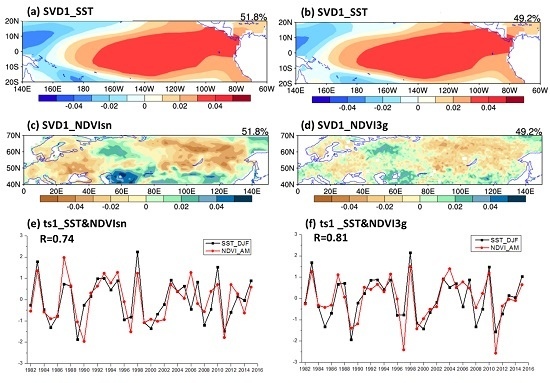Satellite Observations of El Niño Impacts on Eurasian Spring Vegetation Greenness during the Period 1982–2015
Abstract
:1. Introduction
2. Materials and Methods
2.1. NDVI and Climate Data
2.2. Data Processing
2.3. Methods of Spatiotemporal Pattern Analysis
3. Linkage between El Niño and Spring NDVI over Eurasia
3.1. Spatiotemporal Patterns of Spring NDVI
3.2. Correlations between Spring NDVI and El Niño
3.3. Relationship between Spring NDVI Changes and Winter SSTA over Equatorial Pacific
4. Possible Physical Mechanisms for the Teleconnection between ERNDVI and El Niño
4.1. Climatic Impacts on ERNDVI
4.2. Impacts of Atmospheric Teleconnections of El Niño on Spring ERNDVI
5. Discussion
6. Conclusions
- The second EOF mode of spring NDVI, with the “negative-positive-negative” values varying from Europe, West Siberia to East Asia, explains about 12.1% (NDVIsn) and 9.9% (NDVI3g) of the total variance and its time-series is more correlated to the El Niño indices, especially Niño3, Niño3.4 and Niño4, than other climate indices.
- The spatial patterns of correlation coefficients between Eurasian NDVI and different Niño indices also show the patterns of the “negative-positive-negative” values varying from Europe, West Siberia to East Asia, which are similar to the spatial patterns of the second EOF modes obtained from spring Eurasian NDVI.
- Various Niño indices affect spring NDVI changes differently over different areas in Eurasia to various degrees. SSTA in the Niño4 region (CP El Niño events) have closer connections to European NDVI variations (west to 70°E), while SSTA in the Niño3 region (EP El Niño events) impacts primarily East Russian NDVI changes (90°–130°E, 50°–65°N) significantly. The influence of SSTA in the Niño3.4 region seems to have the combined effects of Niño3 and Niño4 indices on Eurasian NDVI variations.
- Temperature anomalies play a leading role as the bridge in explaining the relationship between NDVI and El Niño over Eurasia. The spatial patterns of SST and SAT are similar to those of SST and NDVI via the SVD analysis, exhibiting the “negative-positive-negative” values both in the SAT and NDVI fields from west to east over Eurasia along with an El Niño signal in the SST field.
- East Russia (80°–130°E, 50°–70°N) is identified as the key region with the strongest negative influences from El Niño on spring NDVI growth.
Acknowledgments
Author Contributions
Conflicts of Interest
References
- Bounoua, L.; Collatz, G.; Los, S.; Sellers, P.; Dazlich, D.; Tucker, C.; Randall, D. Sensitivity of climate to changes in NDVI. J. Clim. 2000, 13, 2277–2292. [Google Scholar] [CrossRef]
- Myneni, R.; Dong, J.; Tucker, C.; Kaufmann, R.; Kauppi, P.; Liski, J.; Zhou, L.; Alexeyev, V.; Hughes, M. A large carbon sink in the woody biomass of northern forests. Proc. Natl. Acad. Sci. USA 2001, 98, 14784–14789. [Google Scholar] [CrossRef] [PubMed]
- Zhou, L.; Tucker, C.J.; Kaufmann, R.K.; Slayback, D.; Shabanov, N.V.; Myneni, R.B. Variations in northern vegetation activity inferred from satellite data of vegetation index during 1981 to 1999. J. Geophys. Res. Atmos. 2001, 106, 20069–20083. [Google Scholar] [CrossRef]
- Bogaert, J.; Zhou, L.; Tucker, C.; Myneni, R.; Ceulemans, R. Evidence for a persistent and extensive greening trend in Eurasia inferred from satellite vegetation index data. J. Geophys. Res. Atmos. 2002, 107. [Google Scholar] [CrossRef]
- Zhou, L.; Kaufmann, R.; Tian, Y.; Myneni, R.; Tucker, C. Relation between interannual variations in satellite measures of northern forest greenness and climate between 1982 and 1999. J. Geophys. Res. Atmos. 2003, 108. [Google Scholar] [CrossRef]
- Wang, G.; You, L. Delayed impact of the North Atlantic Oscillation on biosphere productivity in Asia. Geophys. Res. Lett. 2004, 31, L12210. [Google Scholar] [CrossRef]
- Grippa, M.; Kergoat, L.; Le Toan, T.; Mognard, N.; Delbart, N.; L’hermitte, J.; Vicente-Serrano, S. The impact of snow depth and snowmelt on the vegetation variability over central Siberia. Geophys. Res. Lett. 2005, 32, L21412. [Google Scholar] [CrossRef]
- Gutman, G.; Reissell, A. (Eds.) Eurasian Arctic Land Cover and Land Use in a Changing Climate; Springer: Berlin, Germany, 2011. [Google Scholar]
- Chen, H.; Zhang, Y.; Yu, M.; Hua, W.; Sun, S.; Li, X.; Gao, C. Large-scale urbanization effects on eastern Asian summer monsoon circulation and climate. Clim. Dyn. 2016, 47, 117–136. [Google Scholar] [CrossRef]
- Suzuki, R.; Yatagai, A.; Yasunari, T. Satellite-derived vegetation index and evapotranspiration estimated by using assimilated atmospheric data over Asia. J. Meteorol. Soc. Jpn. Ser. II 1998, 76, 663–671. [Google Scholar] [CrossRef]
- Myneni, R.B.; Keeling, C.; Tucker, C.J.; Asrar, G.; Nemani, R.R. Increased plant growth in the northern high latitudes from 1981 to 1991. Nature 1997, 386, 698. [Google Scholar] [CrossRef]
- Wohlfahrt, J.; Harrison, S.; Braconnot, P. Synergistic feedbacks between ocean and vegetation on mid-and high-latitude climates during the mid-Holocene. Clim. Dyn. 2004, 22, 223–238. [Google Scholar] [CrossRef]
- Zhang, X.; Friedl, M.A.; Schaaf, C.B.; Strahler, A.H. Climate controls on vegetation phenological patterns in northern mid-and high latitudes inferred from MODIS data. Glob. Chang. Biol. 2004, 10, 1133–1145. [Google Scholar] [CrossRef]
- Jeong, S.J.; Ho, C.H.; Gim, H.J.; Brown, M.E. Phenology shifts at start vs. end of growing season in temperate vegetation over the Northern Hemisphere for the period 1982–2008. Glob. Chang. Biol. 2011, 17, 2385–2399. [Google Scholar] [CrossRef]
- Peng, S.; Piao, S.; Ciais, P.; Friedlingstein, P.; Zhou, L.; Wang, T. Change in snow phenology and its potential feedback to temperature in the Northern Hemisphere over the last three decades. Environ. Res. Lett. 2013, 8, 014008. [Google Scholar] [CrossRef]
- Tucker, C.J. Red and photographic infrared linear combinations for monitoring vegetation. Remote Sens. Environ. 1979, 8, 127–150. [Google Scholar] [CrossRef]
- Justice, C.O.; Townshend, J.; Holben, B.; Tucker, E.C. Analysis of the phenology of global vegetation using meteorological satellite data. Int. J. Remote Sens. 1985, 6, 1271–1318. [Google Scholar] [CrossRef]
- Moulin, S.; Kergoat, L.; Viovy, N.; Dedieu, G. Global-scale assessment of vegetation phenology using NOAA/AVHRR satellite measurements. J. Clim. 1997, 10, 1154–1170. [Google Scholar] [CrossRef]
- Pettorelli, N.; Vik, J.O.; Mysterud, A.; Gaillard, J.-M.; Tucker, C.J.; Stenseth, N.C. Using the satellite-derived NDVI to assess ecological responses to environmental change. Trends Ecol. Evol. 2005, 20, 503–510. [Google Scholar] [CrossRef] [PubMed]
- Overpeck, J.T.; Rind, D.; Goldberg, R. Climate-induced changes in forest disturbance and vegetation. Nature 1990, 343, 51. [Google Scholar] [CrossRef]
- Heaney, L.R. A synopsis of climatic and vegetational change in Southeast Asia. Clim. Chang. 1991, 19, 53–61. [Google Scholar] [CrossRef]
- Poveda, G.; Salazar, L.F. Annual and interannual (ENSO) variability of spatial scaling properties of a vegetation index (NDVI) in Amazonia. Remote Sens. Environ. 2004, 93, 391–401. [Google Scholar] [CrossRef]
- Roucoux, K.; De Abreu, L.; Shackleton, N.; Tzedakis, P. The response of NW Iberian vegetation to North Atlantic climate oscillations during the last 65kyr. Quat. Sci. Rev. 2005, 24, 1637–1653. [Google Scholar] [CrossRef]
- Scheiter, S.; Higgins, S.I. Impacts of climate change on the vegetation of Africa: An adaptive dynamic vegetation modelling approach. Glob. Chang. Biol. 2009, 15, 2224–2246. [Google Scholar] [CrossRef]
- Gouveia, C.; Trigo, R.M.; DaCamara, C.C.; Libonati, R.; Pereira, J. The North Atlantic oscillation and European vegetation dynamics. Int. J. Climatol. 2008, 28, 1835–1847. [Google Scholar] [CrossRef]
- Cho, M.H.; Lim, G.H.; Song, H.J. The effect of the wintertime Arctic Oscillation on springtime vegetation over the northern high latitude region. Asia Pac. J. Atmos. Sci. 2014, 50, 567–573. [Google Scholar] [CrossRef]
- Li, J.; Fan, K.; Xu, Z. Links between the late wintertime North Atlantic Oscillation and springtime vegetation growth over Eurasia. Clim. Dyn. 2016, 46, 987–1000. [Google Scholar] [CrossRef]
- Power, S.; Casey, T.; Folland, C.; Colman, A.; Mehta, V. Inter-decadal modulation of the impact of ENSO on Australia. Clim. Dyn. 1999, 15, 319–324. [Google Scholar] [CrossRef]
- Sassi, F.; Kinnison, D.; Boville, B.; Garcia, R.; Roble, R. Effect of El Nino—Southern Oscillation on the dynamical, thermal, and chemical structure of the middle atmosphere. J. Geophys. Res. Atmos. 2004, 109, D17108. [Google Scholar] [CrossRef]
- Camp, C.; Tung, K.K. Stratospheric polar warming by ENSO in winter: A statistical study. Geophys. Res. Lett. 2007, 34, L04809. [Google Scholar] [CrossRef]
- Polis, G.A.; Hurd, S.D.; Jackson, C.T.; Piñero, F.S. El Niño effects on the dynamics and control of anisland ecosystem in the Gulf of California. Ecology 1997, 78, 1884–1897. [Google Scholar]
- Jaksic, F.M. Ecological effects of El Nino in terrestrial ecosystems of western South America. Ecography 2001, 24, 241–250. [Google Scholar] [CrossRef]
- Li, J.; Fan, K.; Xu, Z. Asymmetric response in Northeast Asia of summer NDVI to the preceding ENSO cycle. Clim. Dyn. 2016, 47, 2765–2783. [Google Scholar] [CrossRef]
- Hua, W.; Zhou, L.; Chen, H.; Nicholson, S.E.; Jiang, Y.; Raghavendra, A. Understanding the Central Equatorial African long-term drought using AMIP-type simulations. Clim. Dyn. 2017. [Google Scholar] [CrossRef]
- Asner, G.P.; Townsend, A.R.; Braswell, B.H. Satellite observation of El Nino effects on Amazon forest phenology and productivity. Geophys. Res. Lett. 2000, 27, 981–984. [Google Scholar] [CrossRef]
- Anyamba, A.; Tucker, C.; Eastman, J. NDVI anomaly patterns over Africa during the 1997/98 ENSO warm event. Int. J. Remote Sens. 2001, 22, 1847–1860. [Google Scholar]
- Alencar, A.; Nepstad, D.; Diaz, M.C.V. Forest understory fire in the Brazilian Amazon in ENSO and non-ENSO years: Area burned and committed carbon emissions. Earth Interact. 2006, 10, 1–17. [Google Scholar] [CrossRef]
- Hua, W.; Zhou, L.; Chen, H.; Nicholson, S.E.; Raghavendra, A.; Jiang, Y. Possible causes of the Central Equatorial African long-term drought. Environ. Res. Lett. 2016, 11, 124002. [Google Scholar] [CrossRef]
- Ropelewski, C.F.; Halpert, M.S. Global and regional scale precipitation patterns associated with the El Niño/Southern Oscillation. Mon. Weather Rev. 1987, 115, 1606–1626. [Google Scholar] [CrossRef]
- Dillon, M.O.; Rundel, P.W. The botanical response of the Atacama and Peruvian Desert floras to the 1982–83 El Niño event. Elsevier Oceanogr. Ser. 1990, 52, 487–504. [Google Scholar]
- Holmgren, M.; Scheffer, M. El Niño as a window of opportunity for the restoration of degraded arid ecosystems. Ecosystems 2001, 4, 151–159. [Google Scholar] [CrossRef]
- Karoly, D.J. Southern hemisphere circulation features associated with El Niño-Southern Oscillation events. J. Clim 1989, 2, 1239–1252. [Google Scholar] [CrossRef]
- Tudhope, A.W.; Chilcott, C.P.; McCulloch, M.T.; Cook, E.R.; Chappell, J.; Ellam, R.M.; Lea, D.W.; Lough, J.M.; Shimmield, G.B. Variability in the El Niño-Southern Oscillation through a glacial-interglacial cycle. Science 2001, 291, 1511–1517. [Google Scholar] [CrossRef] [PubMed]
- Xu, J.; Chan, J.C. The role of the Asian–Australian monsoon system in the onset time of El Nino events. J. Clim. 2001, 14, 418–433. [Google Scholar] [CrossRef]
- Lu, J.; Chen, G.; Frierson, D.M. Response of the zonal mean atmospheric circulation to El Niño versus global warming. J. Clim. 2008, 21, 5835–5851. [Google Scholar] [CrossRef]
- Zhou, B.; Xu, Y.; Shi, Y. Present and future connection of Asian-Pacific Oscillation to large-scale atmospheric circulations and East Asian rainfall: Results of CMIP5. Clim. Dyn. 2017. [Google Scholar] [CrossRef]
- Li, C. Interaction between anomalous winter monsoon in East Asia and El Nino events. Adv. Atmos. Sci. 1990, 7, 36–46. [Google Scholar]
- Fu, C.; Jiang, Z.; Guan, Z.; He, J.; Xu, Z. Interannual variability of summer climate of China in association with ENSO and the Indian Ocean dipole. In Regional Climate Studies of China; Springer: Berlin/Heidelberg, Germany, 2008; pp. 119–154. [Google Scholar]
- Wang, H. The instability of the East Asian summer monsoon—ENSO relations. Adv. Atmos. Sci. 2002, 19, 1–11. [Google Scholar]
- Scheftic, W.; Zeng, X.; Broxton, P.; Brunke, M. Intercomparison of seven NDVI products over the United States and Mexico. Remote Sens. 2014, 6, 1057–1084. [Google Scholar] [CrossRef]
- Gamon, J.A.; Field, C.B.; Goulden, M.L.; Griffin, K.L.; Hartley, A.E.; Joel, G.; Penuelas, J.; Valentini, R. Relationships between NDVI, canopy structure, and photosynthesis in three Californian vegetation types. Ecol. Appl. 1995, 5, 28–41. [Google Scholar] [CrossRef]
- Carlson, T.N.; Ripley, D.A. On the relation between NDVI, fractional vegetation cover, and leaf area index. Remote Sens. Environ. 1997, 62, 241–252. [Google Scholar] [CrossRef]
- Houborg, R.; Soegaard, H.; Boegh, E. Combining vegetation index and model inversion methods for the extraction of key vegetation biophysical parameters using Terra and Aqua MODIS reflectance data. Remote Sens. Environ. 2007, 106, 39–58. [Google Scholar] [CrossRef]
- Bannari, A.; Morin, D.; Bonn, F.; Huete, A. A review of vegetation indices. Remote Sens. Rev. 1995, 13, 95–120. [Google Scholar] [CrossRef]
- Tucker, C.J.; Pinzon, J.E.; Brown, M.E.; Slayback, D.A.; Pak, E.W.; Mahoney, R.; Vermote, E.F.; El Saleous, N. An extended AVHRR 8-km NDVI dataset compatible with MODIS and SPOT vegetation NDVI data. Int. J. Remote Sens. 2005, 26, 4485–4498. [Google Scholar] [CrossRef]
- Li, J.; Fan, K.; Xu, J.; Powell, A.M.; Kogan, F. The effect of preceding wintertime Arctic polar vortex on springtime NDVI patterns in boreal Eurasia, 1982–2015. Clim. Dyn. 2016. [Google Scholar] [CrossRef]
- Holben, B.N. Characteristics of maximum-value composite images from temporal AVHRR data. Int. J. Remote Sens. 1986, 7, 1417–1434. [Google Scholar] [CrossRef]
- Wang, D.; Morton, D.; Masek, J.; Wu, A.; Nagol, J.; Xiong, X.; Levy, R.; Vermote, E.; Wolfe, R. Impact of sensor degradation on the MODIS NDVI time series. Remote Sens. Environ. 2012, 119, 55–61. [Google Scholar] [CrossRef]
- Dee, D.; Uppala, S.; Simmons, A.; Berrisford, P.; Poli, P.; Kobayashi, S.; Andrae, U.; Balmaseda, M.; Balsamo, G.; Bauer, P. The ERA-Interim reanalysis: Configuration and performance of the data assimilation system. Q. J. R. Meteorol. Soc. 2011, 137, 553–597. [Google Scholar] [CrossRef]
- Trenberth, K.E.; Stepaniak, D.P. Indices of El Niño evolution. J. Clim. 2001, 14, 1697–1701. [Google Scholar] [CrossRef]
- Smith, C.A.; Sardeshmukh, P.D. The effect of ENSO on the intraseasonal variance of surface temperatures in winter. Int. J. Climatol. 2000, 20, 1543–1557. [Google Scholar] [CrossRef]
- Larkin, N.K.; Harrison, D. On the definition of El Niño and associated seasonal average US weather anomalies. Geophys. Res. Lett. 2005, 32, L13705. [Google Scholar] [CrossRef]
- Kao, H.Y.; Yu, J.Y. Contrasting eastern-Pacific and central-Pacific types of ENSO. J. Clim. 2009, 22, 615–632. [Google Scholar] [CrossRef]
- Kug, J.S.; Jin, F.F.; An, S.I. Two-types of El Nino events: Cold tongue El Nino and warm Pool El Nino. J. Clim. 2009, 22, 1499–1515. [Google Scholar] [CrossRef]
- Ren, H.L.; Jin, F.F. Niño indices for two types of ENSO. Geophys. Res. Lett. 2011, 38, L04704. [Google Scholar] [CrossRef]
- Badeck, F.W.; Bondeau, A.; Böttcher, K.; Doktor, D.; Lucht, W.; Schaber, J.; Sitch, S. Responses of spring phenology to climate change. New Phytol. 2004, 162, 295–309. [Google Scholar] [CrossRef]
- Menzel, A.; Sparks, T.H.; Estrella, N.; Koch, E.; Aasa, A.; Ahas, R.; Alm-Kübler, K.; Bissolli, P.; Braslavská, O.G.; Briede, A. European phenological response to climate change matches the warming pattern. Glob. Chang. Biol. 2006, 12, 1969–1976. [Google Scholar] [CrossRef]
- Cleland, E.E.; Chuine, I.; Menzel, A.; Mooney, H.A.; Schwartz, M.D. Shifting plant phenology in response to global change. Trends Ecol. Evol. 2007, 22, 357–365. [Google Scholar] [CrossRef] [PubMed]
- Suzuki, R.; Tanaka, S.; Yasunari, T. Relationships between meridional profiles of satellite-derived vegetation index(NDVI) and climate over Siberia. Int. J. Climatol. 2000, 20, 955–967. [Google Scholar] [CrossRef]
- Gong, D.Y.; Shi, P.J. Northern hemispheric NDVI variations associated with large-scale climate indices in spring. Int. J. Remote Sens. 2003, 24, 2559–2566. [Google Scholar] [CrossRef]
- Weare, B.C.; Nasstrom, J.S. Examples of extended empirical orthogonal function analyses. Mon. Weather Rev. 1982, 110, 481–485. [Google Scholar] [CrossRef]
- Prohaska, J.T. A technique for analyzing the linear relationships between two meteorological fields. Mon. Weather Rev. 1976, 104, 1345–1353. [Google Scholar] [CrossRef]
- Wallace, J.M.; Smith, C.; Bretherton, C.S. Singular value decomposition of wintertime sea surface temperature and 500-mb height anomalies. J. Clim. 1992, 5, 561–576. [Google Scholar] [CrossRef]
- Chang, P.; Ji, L.; Li, H. A decadal climate variation in the tropical Atlantic Ocean from thermodynamic air-sea interactions. Nature 1997, 385, 516. [Google Scholar] [CrossRef]
- Robertson, A.W.; Mechoso, C.R.; Kim, Y.-J. The influence of Atlantic sea surface temperature anomalies on the North Atlantic Oscillation. J. Clim. 2000, 13, 122–138. [Google Scholar] [CrossRef]
- Hurrell, J.W. Decadal trends in the North Atlantic oscillation. Clim. Chang. Eval. Recent Future Clim. Chang. 2002, 4, 201. [Google Scholar]
- Björnsson, H.; Venegas, S. A manual for EOF and SVD analyses of climatic data. CCGCR Rep. 1997, 97, 112–134. [Google Scholar]
- Li, A.; Liang, S.; Wang, A.; Huang, C. Investigating the impacts of the North Atlantic Oscillation on global vegetation changes by a remotely sensed vegetation index. Int. J. Remote Sens. 2012, 33, 7222–7239. [Google Scholar] [CrossRef]
- Thompson, D.W.; Wallace, J.M. The Arctic Oscillation signature in the wintertime geopotential height and temperature fields. Geophys. Res. Lett. 1998, 25, 1297–1300. [Google Scholar] [CrossRef]
- Ogi, M.; Tachibana, Y.; Yamazaki, K. Impact of the wintertime North Atlantic Oscillation (NAO) on the summertime atmospheric circulation. Geophys. Res. Lett. 2003, 30, 1704. [Google Scholar] [CrossRef]
- Robock, A.; Mu, M.; Vinnikov, K.; Robinson, D. Land surface conditions over Eurasia and Indian summer monsoon rainfall. J. Geophys. Res. Atmos. 2003, 108. [Google Scholar] [CrossRef]
- Mann, M.E.; Zhang, Z.; Rutherford, S.; Bradley, R.S.; Hughes, M.K.; Shindell, D.; Ammann, C.; Faluvegi, G.; Ni, F. Global signatures and dynamical origins of the Little Ice Age and Medieval Climate Anomaly. Science 2009, 326, 1256–1260. [Google Scholar] [CrossRef] [PubMed]
- Tian, B.; Fan, K. A skillful prediction model for winter NAO based on Atlantic sea surface temperature and Eurasian snow cover. Weather Forecast. 2015, 30, 197–205. [Google Scholar] [CrossRef]
- Fan, K.; Tian, B.; Wang, H. New approaches for the skillful prediction of the winter North Atlantic Oscillation based on coupled dynamic climate models. Int. J. Climatol. 2016, 36, 82–94. [Google Scholar] [CrossRef]
- Hurrell, J. NAO Index Data Provided by the Climate Analysis Section; NCAR: Boulder, CO, USA, 1995. Available online: http://www.cgd. ucar.edu/cas/jhurrell/indices.html (accessed on 25 April 2017).
- Rigor, I.G.; Colony, R.L.; Martin, S. Variations in surface air temperature observations in the Arctic, 1979–97. J. Clim. 2000, 13, 896–914. [Google Scholar] [CrossRef]
- Lieth, H. Purposes of a phenology book. In Phenology and Seasonality Modeling; Springer: New York, NY, USA, 1974; pp. 3–19. [Google Scholar]
- Thorn, V.C.; DeConto, R. Antarctic climate at the Eocene/Oligocene boundary—Climate model sensitivity to high latitude vegetation type and comparisons with the palaeobotanical record. Palaeogeogr. Palaeoclimatol. Palaeoecol. 2006, 231, 134–157. [Google Scholar] [CrossRef]
- Ebata, M.; Tateishi, R. Phenological stage monitoring in Siberia by using NOAA/AVHRR data. In Proceedings of the 22nd Asian Conference on Remote Sensing, Singapore, 5–9 November 2001. [Google Scholar]
- Los, S.O.; Collatz, G.J.; Bounoua, L.; Sellers, P.J.; Tucker, C.J. Global interannual variations in sea surface temperature and land surface vegetation, air temperature, and precipitation. J. Clim. 2001, 14, 1535–1549. [Google Scholar] [CrossRef]
- Yu, J.Y.; Kim, S.T. Identifying the types of major El Niño events since 1870. Int. J. Climatol. 2013, 33, 2105–2112. [Google Scholar] [CrossRef]
- Chan, J.C. Tropical cyclone activity in the northwest Pacific in relation to the El Niño/Southern Oscillation phenomenon. Mon. Weather Rev. 1985, 113, 599–606. [Google Scholar] [CrossRef]
- Wu, M.; Chang, W.; Leung, W. Impacts of El Niño–Southern Oscillation events on tropical cyclone landfalling activity in the western North Pacific. J. Clim. 2004, 17, 1419–1428. [Google Scholar] [CrossRef]
- Zhang, R.; Sumi, A.; Kimoto, M. Impact of El Niño on the East Asian monsoon. J. Meteorol. Soc. Jpn. Ser. II 1996, 74, 49–62. [Google Scholar] [CrossRef]
- Xie, S.P.; Hu, K.; Hafner, J.; Tokinaga, H.; Du, Y.; Huang, G.; Sampe, T. Indian Ocean capacitor effect on Indo–western Pacific climate during the summer following El Niño. J. Clim. 2009, 22, 730–747. [Google Scholar] [CrossRef]
- Takaya, K.; Nakamura, H. A formulation of a wave-activity flux for stationary Rossby waves on a zonally varying basic flow. Geophys. Res. Lett. 1997, 24, 2985–2988. [Google Scholar] [CrossRef]
- Takaya, K.; Nakamura, H. A formulation of a phase-independent wave-activity flux for stationary and migratory quasigeostrophic eddies on a zonally varying basic flow. J. Atmos. Sci. 2001, 58, 608–627. [Google Scholar] [CrossRef]
- Wu, R.; Kirtman, B.P.; Krishnamurthy, V. An asymmetric mode of tropical Indian Ocean rainfall variability in boreal spring. J. Geophys. Res. Atmos. 2008, 113, D05104. [Google Scholar] [CrossRef]
- Huang, B.; Kinter, J.L. Interannual variability in the tropical Indian Ocean. J. Geophys. Res. Oceans 2002, 107, 20.1–20.26. [Google Scholar] [CrossRef]
- Xie, S.P.; Annamalai, H.; Schott, F.A.; McCreary, J.P., Jr. Structure and mechanisms of South Indian Ocean climate variability. J. Clim. 2002, 15, 864–878. [Google Scholar] [CrossRef]
- Klein, S.A.; Soden, B.J.; Lau, N.C. Remote sea surface temperature variations during ENSO: Evidence for a tropical atmospheric bridge. J. Clim. 1999, 12, 917–932. [Google Scholar] [CrossRef]
- Tokinaga, H.; Tanimoto, Y. Seasonal transition of SST anomalies in the tropical Indian Ocean during El Niño and Indian Ocean dipole years. J. Meteorol. Soc. Jpn. Ser. II 2004, 82, 1007–1018. [Google Scholar] [CrossRef]
- Meyers, G.; McIntosh, P.; Pigot, L.; Pook, M. The years of El Niño, La Niña, and interactions with the tropical Indian Ocean. J. Clim. 2007, 20, 2872–2880. [Google Scholar] [CrossRef]
- Xie, S.; Philander, S.G.H. A coupled ocean-atmosphere model of relevance to the ITCZ in the eastern Pacific. Tellus A 1994, 46, 340–350. [Google Scholar] [CrossRef]
- Xu, Z.; Fan, K.; Wang, H. Role of sea surface temperature anomalies in the tropical Indo-Pacific region in the northeast Asia severe drought in summer 2014: Month-to-month perspective. Clim. Dyn. 2016. [Google Scholar] [CrossRef]
- Kawamura, R.; Matsuura, T.; Iizuka, S. Role of equatorially asymmetric sea surface temperature anomalies in the Indian Ocean in the Asian summer monsoon and El Niño-Southern Oscillation coupling. J. Geophys. Res. Atmos. 2001, 106, 4681–4693. [Google Scholar] [CrossRef]
- Hoskins, B.J.; Karoly, D.J. The steady linear response of a spherical atmosphere to thermal and orographic forcing. J. Atmos. Sci. 1981, 38, 1179–1196. [Google Scholar] [CrossRef]
- Sardeshmukh, P.D.; Hoskins, B.J. The generation of global rotational flow by steady idealized tropical divergence. J. Atmos. Sci. 1988, 45, 1228–1251. [Google Scholar] [CrossRef]
- Chen, G.; Huang, R. Excitation mechanisms of the teleconnection patterns affecting the July precipitation in Northwest China. J. Clim. 2012, 25, 7834–7851. [Google Scholar] [CrossRef]
- Held, I.M.; Ting, M.; Wang, H. Northern winter stationary waves: Theory and modeling. J. Clim. 2002, 15, 2125–2144. [Google Scholar] [CrossRef]
- Buermann, W.; Anderson, B.; Tucker, C.J.; Dickinson, R.E.; Lucht, W.; Potter, C.S.; Myneni, R.B. Interannual covariability in Northern Hemisphere air temperatures and greenness associated with El Niño-Southern Oscillation and the Arctic Oscillation. J. Geophys. Res. Atmos. 2003, 108, 4396. [Google Scholar] [CrossRef]
- Balzter, H.; Gerard, F.; George, C.; Weedon, G.; Grey, W.; Combal, B.; Bartholomé, E.; Bartalev, S.; Los, S. Coupling of vegetation growing season anomalies and fire activity with hemispheric and regional-scale climate patterns in central and east Siberia. J. Clim. 2007, 20, 3713–3729. [Google Scholar] [CrossRef]
- Gong, D.Y.; Ho, C.H. Detection of large-scale climate signals in spring vegetation index (normalized difference vegetation index) over the Northern Hemisphere. J. Geophys. Res. Atmos. 2003, 108. [Google Scholar] [CrossRef]
- Graf, H.F.; Zanchettin, D. Central Pacific El Niño, the “subtropical bridge,” and Eurasian climate. J. Geophys. Res. Atmos. 2012, 117, D01102. [Google Scholar] [CrossRef]
- Moron, V.; Plaut, G. The impact of El Nino—southern oscillation upon weather regimes over Europe and the North Atlantic during boreal winter. Int. J. Climatol. 2003, 23, 363–379. [Google Scholar] [CrossRef]
- Clutton-Brock, T.; Coulson, T. Comparative ungulate dynamics: The devil is in the detail. Philos. Trans. R. Soc. Lond. B Biol. Sci. 2002, 357, 1285–1298. [Google Scholar] [CrossRef] [PubMed]
- Bastos, A.; Ciais, P.; Park, T.; Zscheischler, J.; Yue, C.; Barichivich, J.; Myneni, R.B.; Peng, S.; Piao, S.; Zhu, S. Was the extreme Northern Hemisphere greening in 2015 predictable? Environ. Res. Lett. 2017, 12, 044016. [Google Scholar] [CrossRef]
- Hallett, T.; Coulson, T.; Pilkington, J.; Clutton-Brock, T.; Pemberton, J.; Grenfell, B. Why large-scale climate indices seem to predict ecological processes better than local weather. Nature 2004, 430, 71–75. [Google Scholar] [CrossRef] [PubMed]
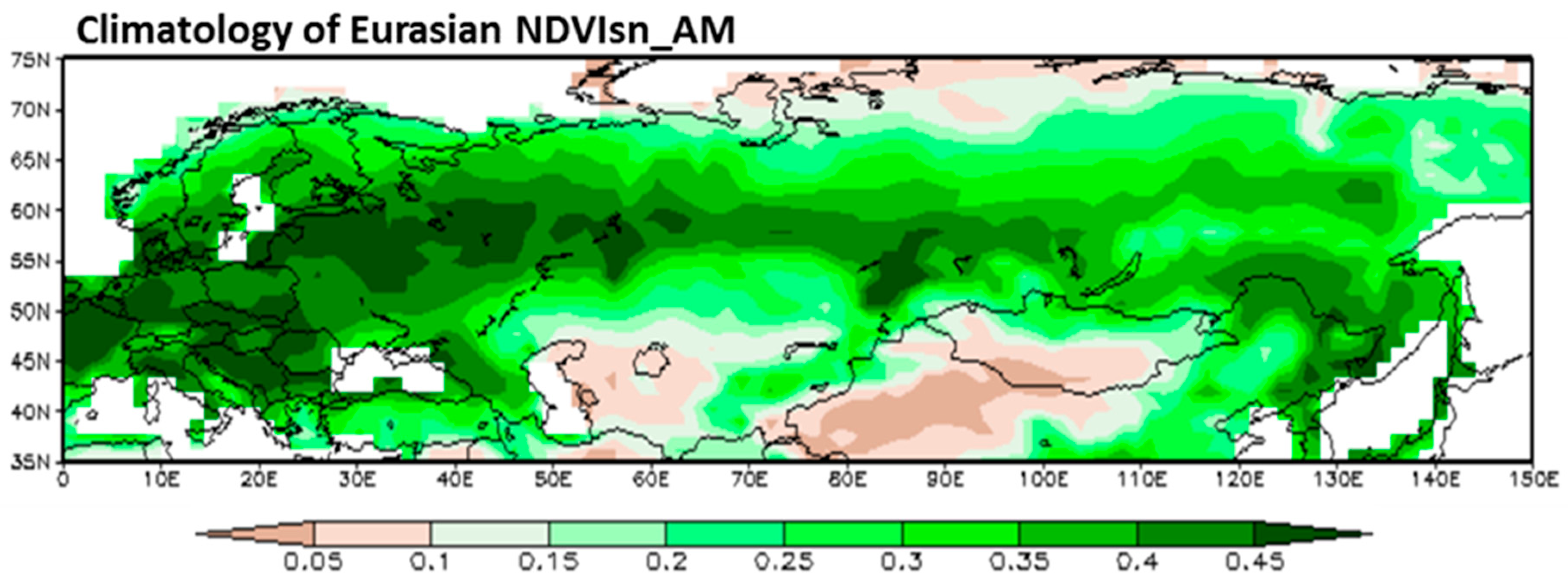
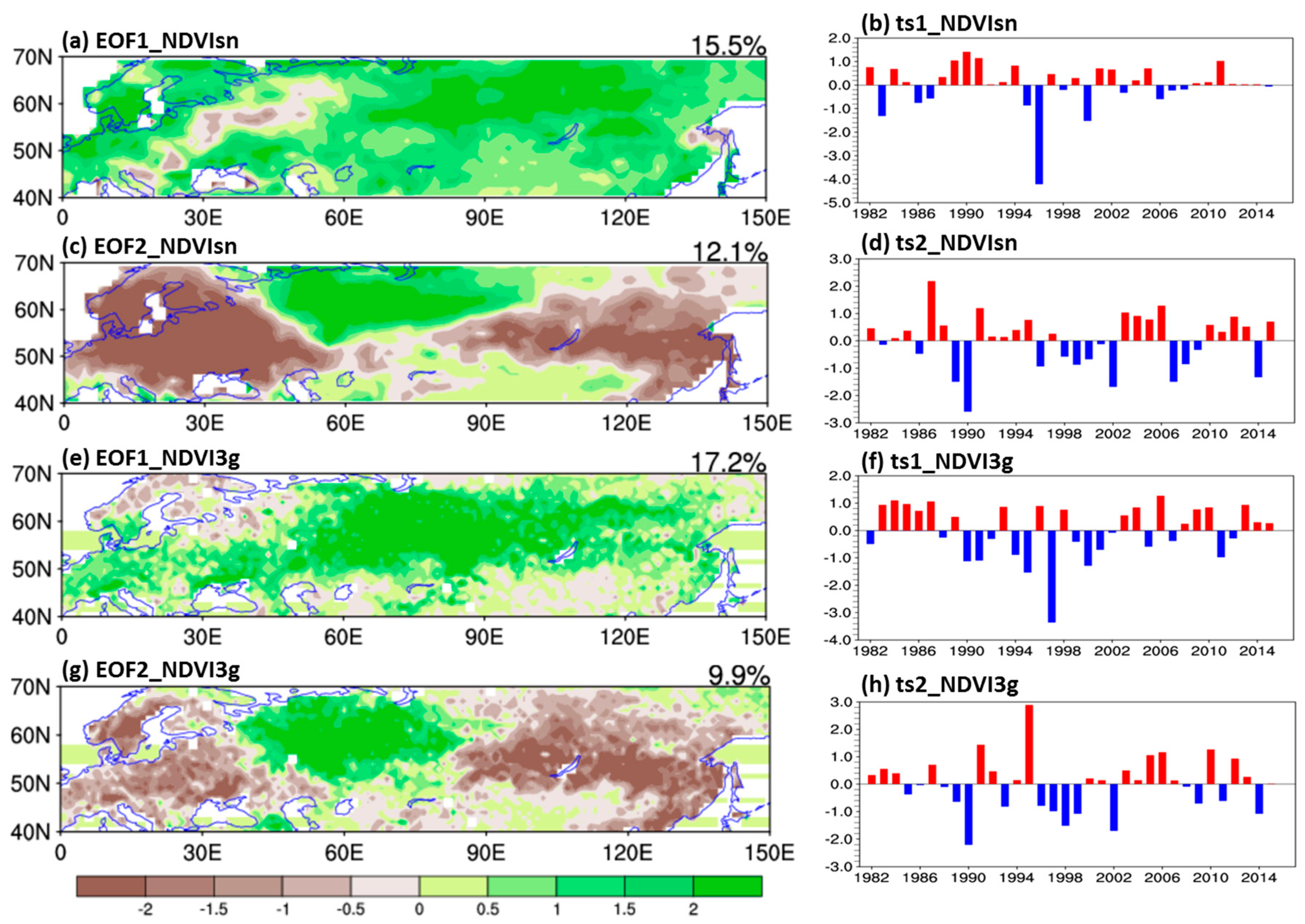

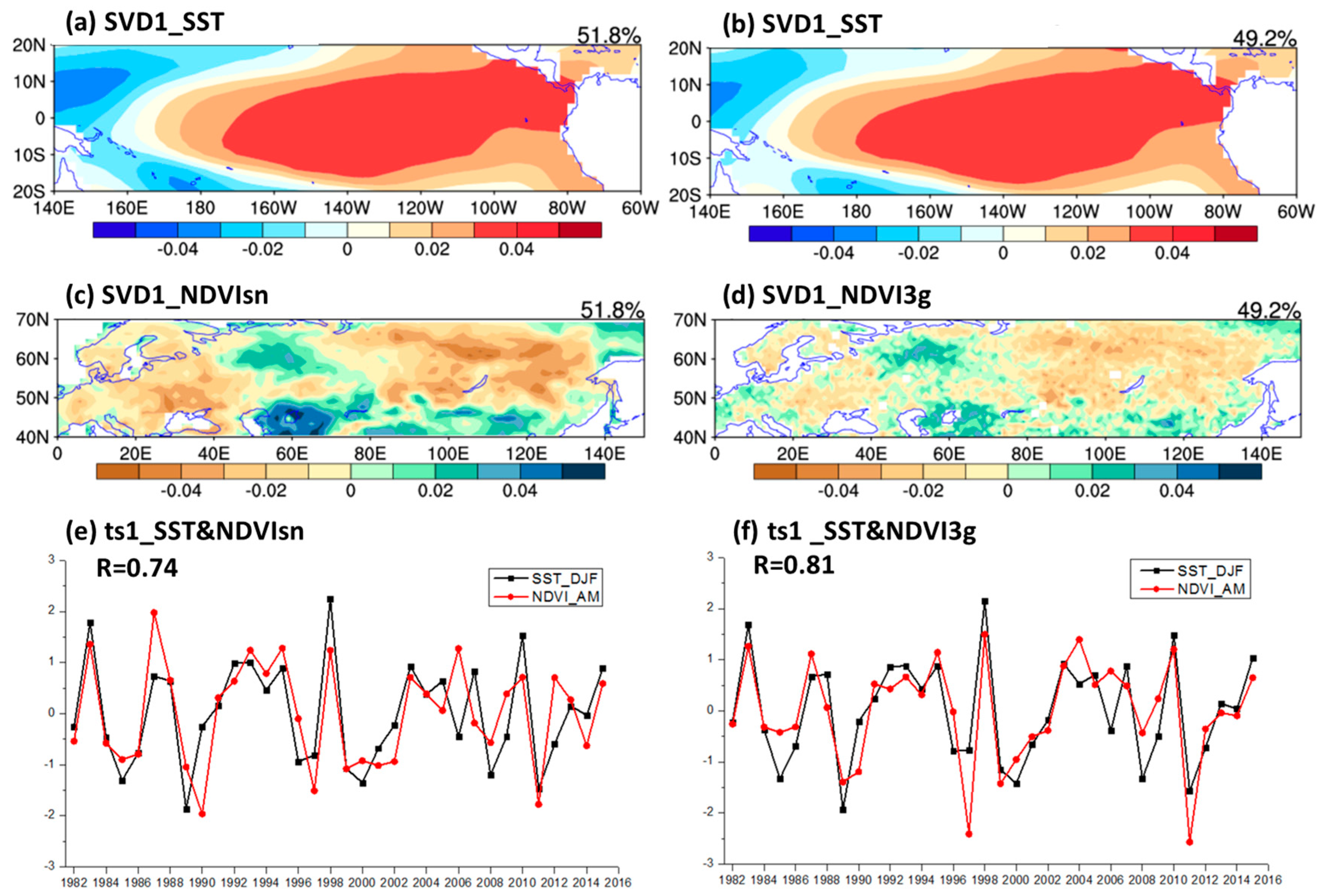
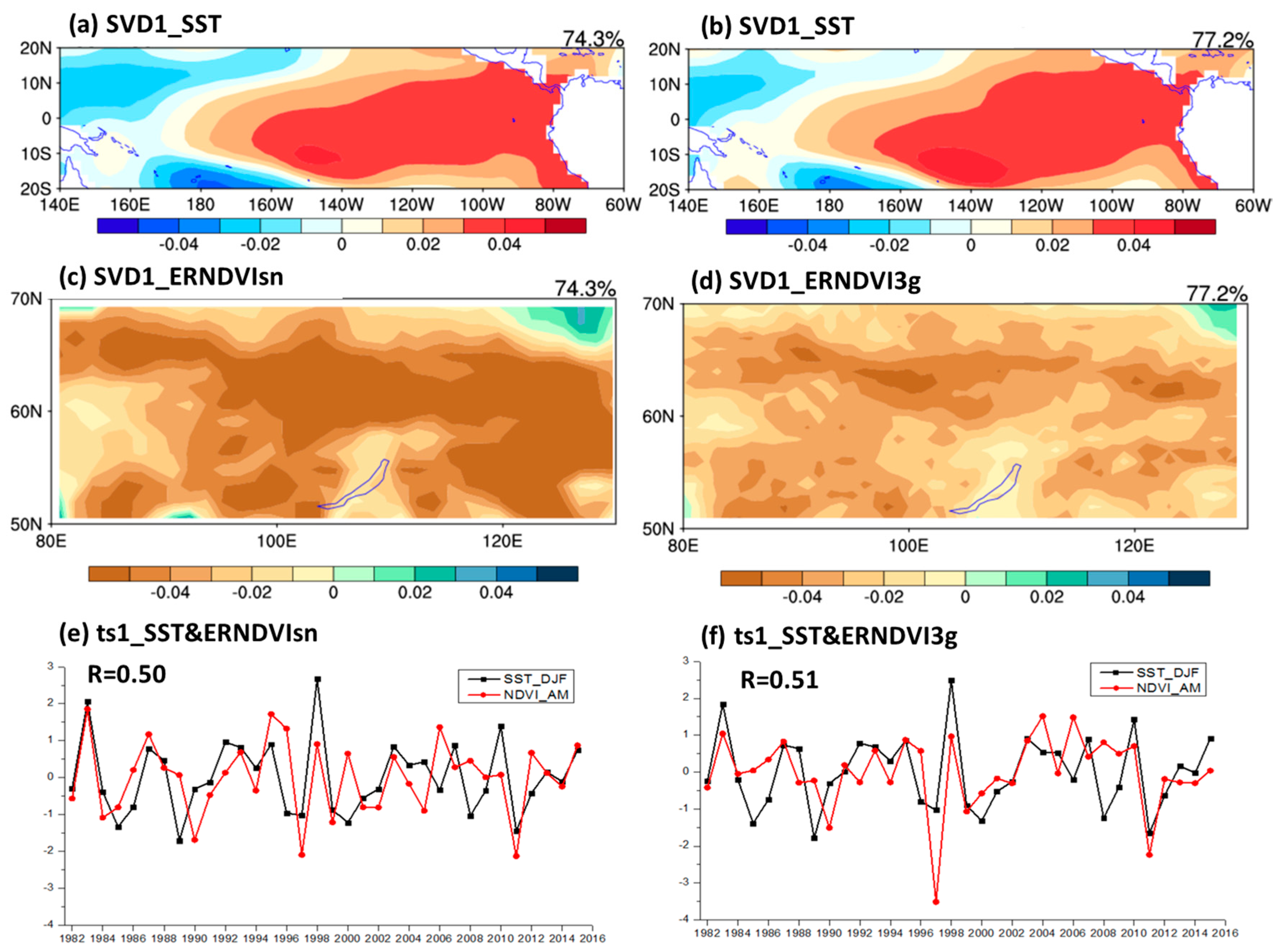
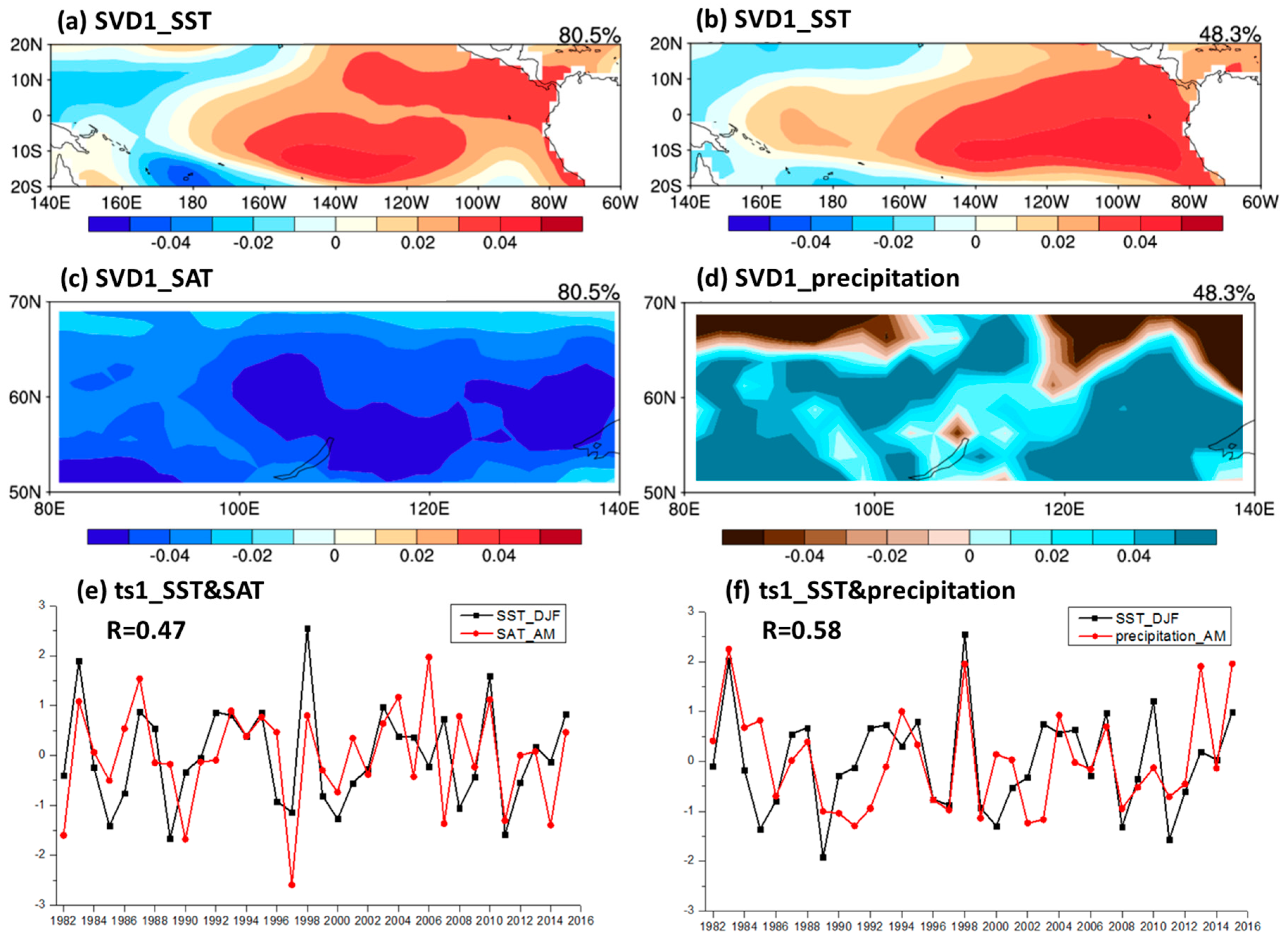
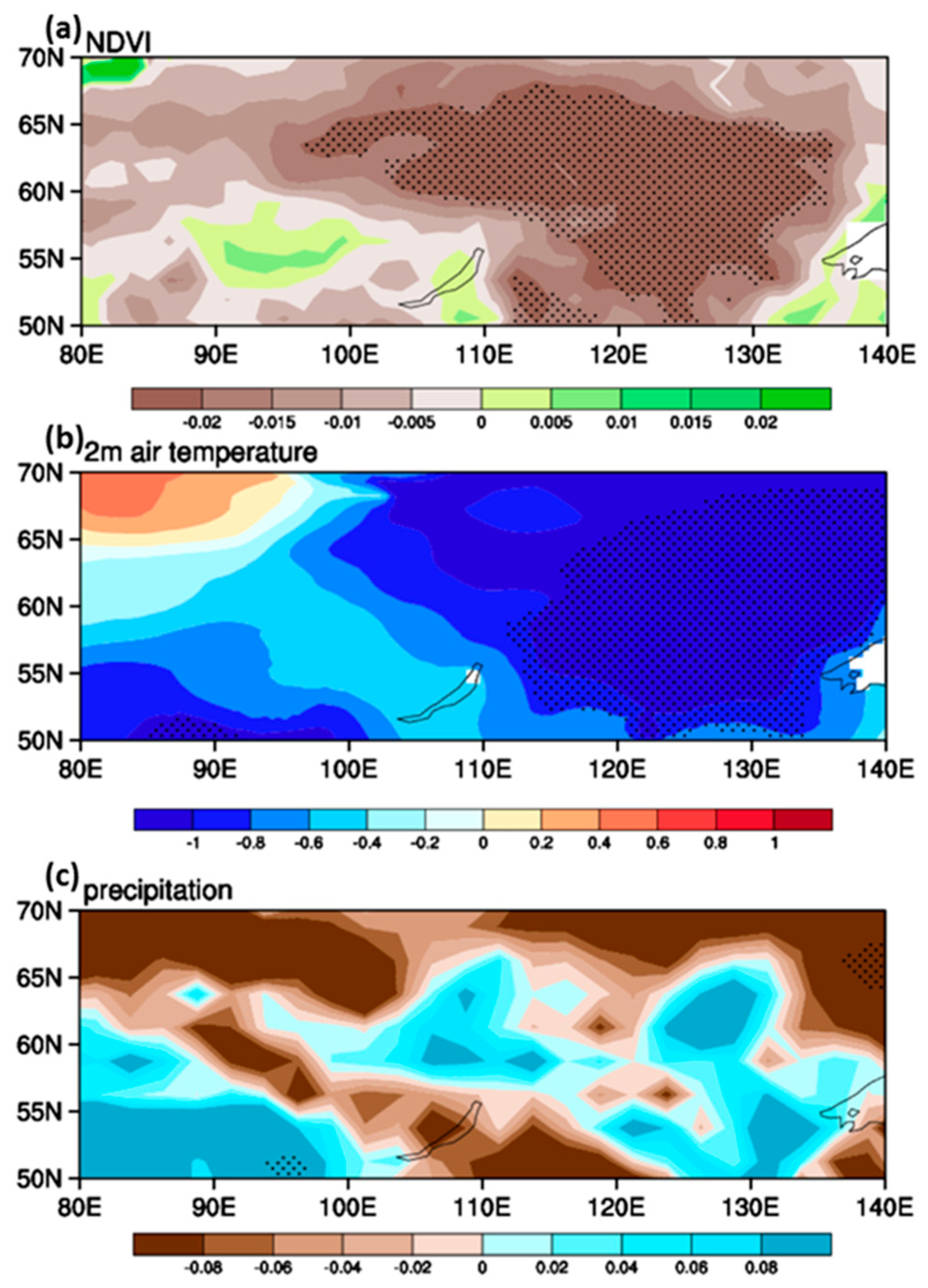
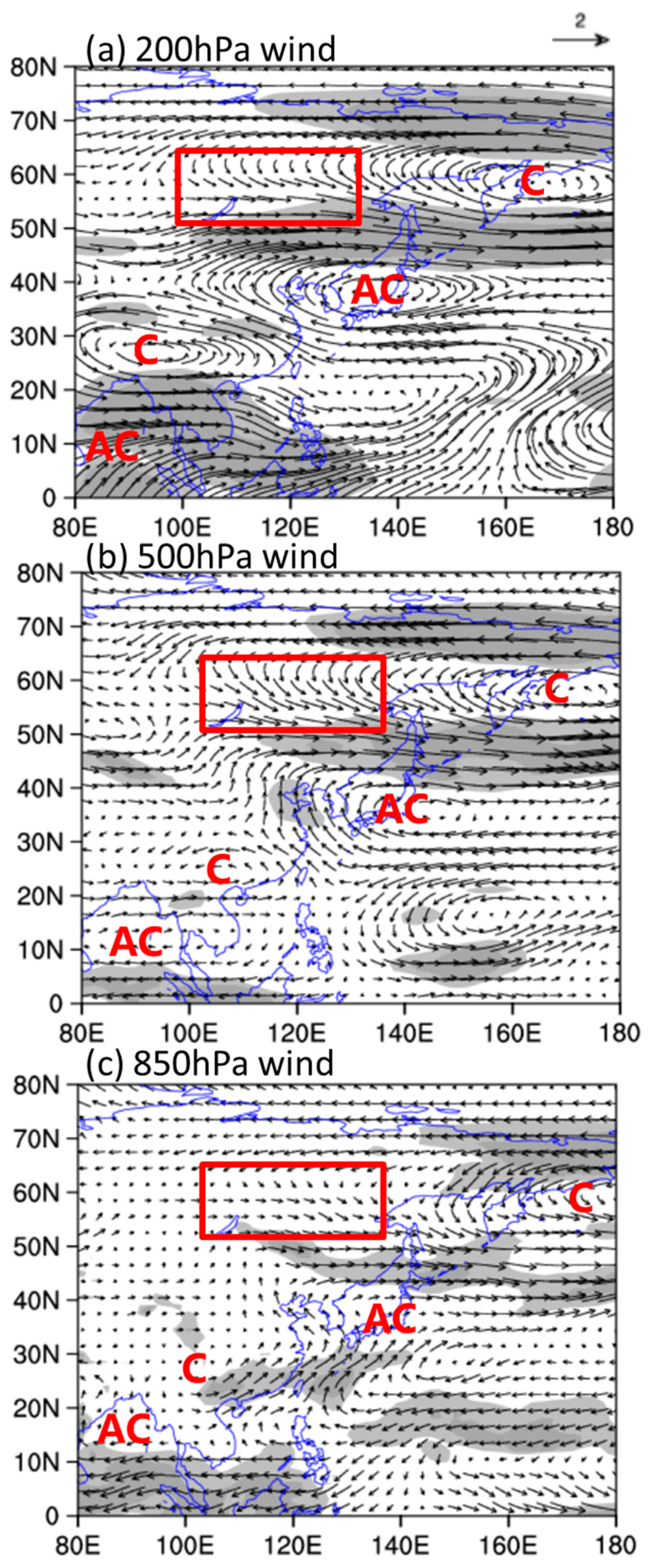

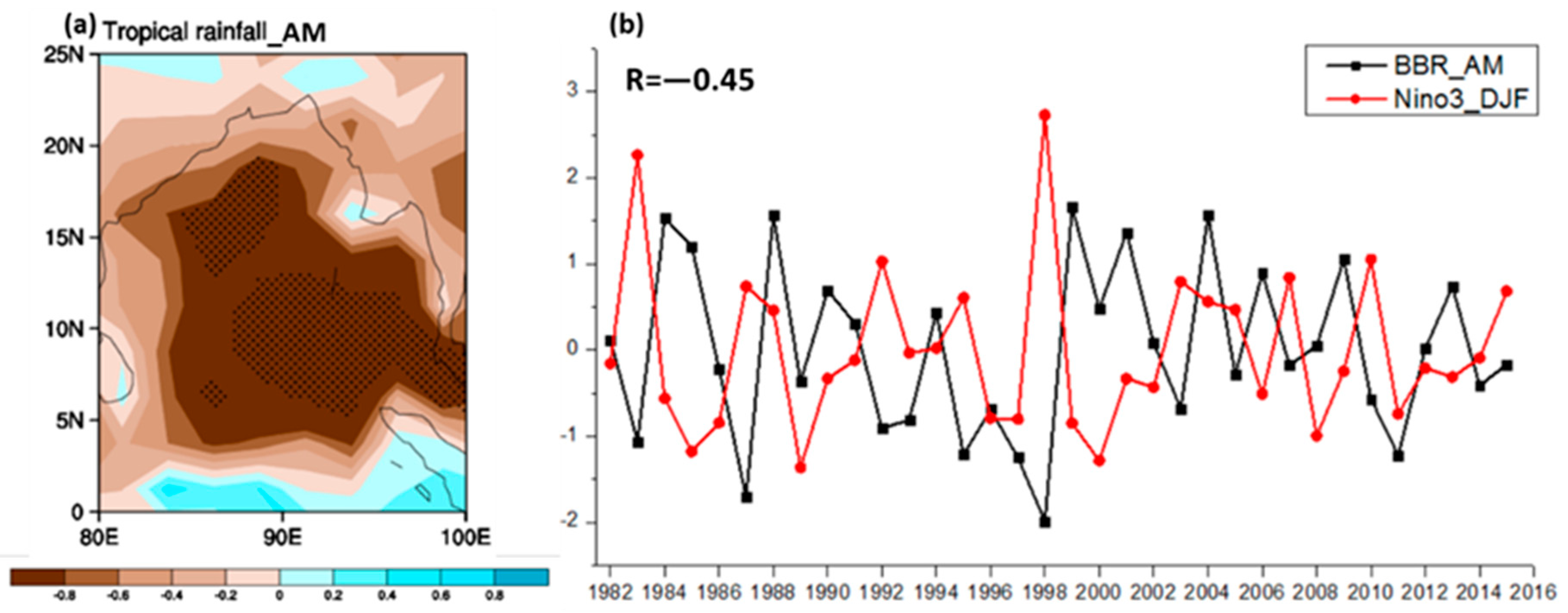
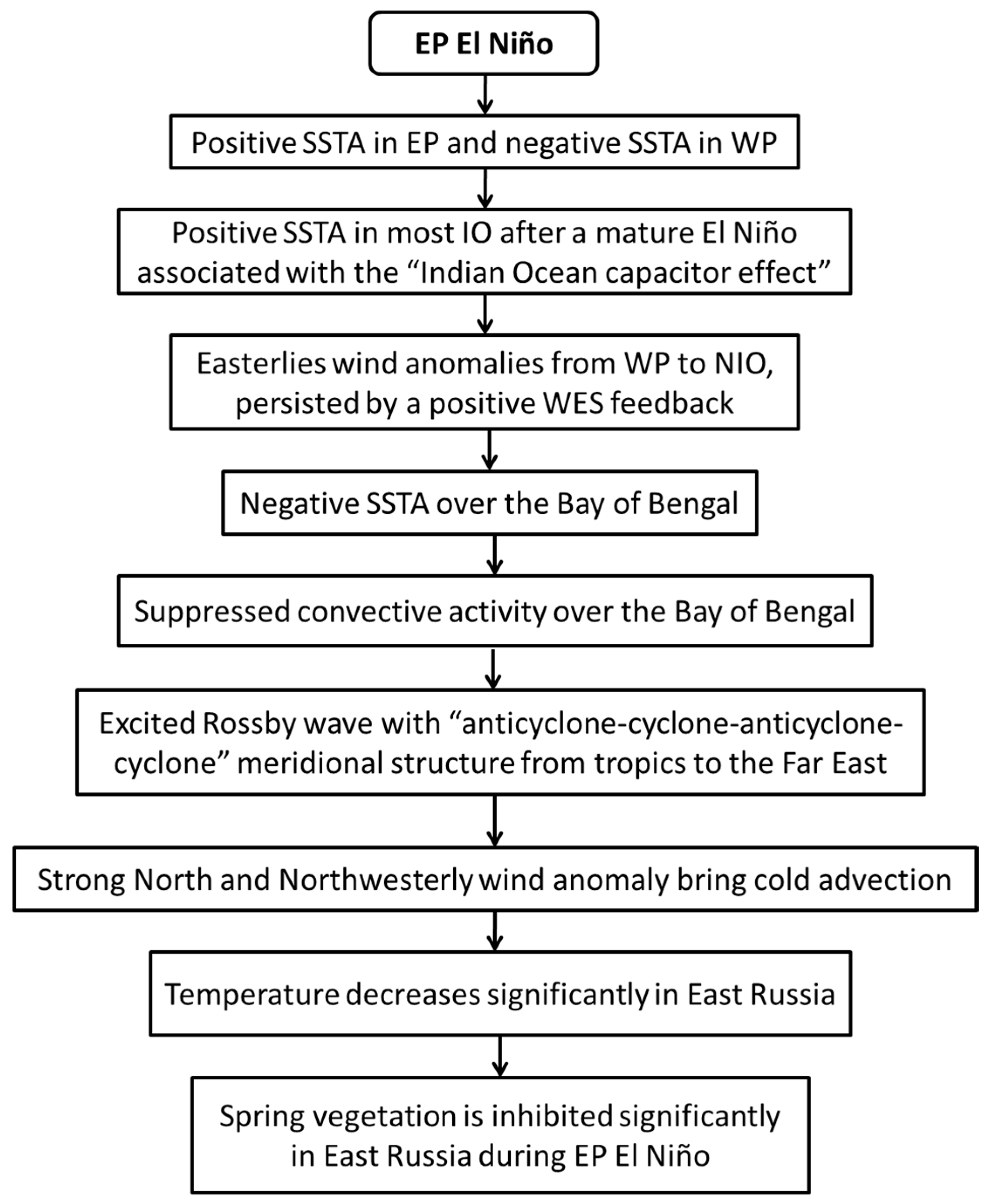
| Dataset | Provider | Sensor | Temporal Span | Spatial Resolution | Compositing |
|---|---|---|---|---|---|
| NDVI3g | GIMMS | AVHRR | 1981–2015 | 1/12 deg | MVC |
| NDVIsn | STAR | AVHRR | 1981–present | 16 km | MVC smoothed |
| Indices | NDVIsn_ts1 | NDVIsn_ts2 | NDVI3g_ts1 | NDVI3g_ts2 |
|---|---|---|---|---|
| Niño1+2 | −0.21 | −0.04 | −0.14 | −0.07 |
| Niño3 | −0.19 | −0.22 * | −0.07 | −0.24 * |
| Niño3.4 | −0.12 | −0.29 † | −0.05 | −0.30 † |
| Niño4 | 0.01 | −0.30 † | 0.01 | −0.31 † |
| BEST | −0.20 | −0.24 * | −0.14 | −0.21 |
| NAO | 0.40 ‡ | 0.20 | 0.39 ‡ | 0.23 * |
| AO | 0.51 ‡ | 0.27 * | 0.40 ‡ | 0.36 ‡ |
| Time-series | Niño3 | Niño4 | Niño3.4 | Niño1+2 | NAO | AO |
|---|---|---|---|---|---|---|
| SST_NDVIsn | 0.97 * | 0.82 | 0.97 | 0.86 | / | / |
| NDVI_NDVIsn | 0.51 * | 0.31 | 0.45 | 0.50 | −0.01 | −0.15 |
| SST_NDVI3g | 0.94 * | 0.83 | 0.94 | 0.79 | / | / |
| NDVI_NDVI3g | 0.43 * | 0.28 | 0.38 | 0.40 | −0.27 | −0.37 |
© 2017 by the authors. Licensee MDPI, Basel, Switzerland. This article is an open access article distributed under the terms and conditions of the Creative Commons Attribution (CC BY) license (http://creativecommons.org/licenses/by/4.0/).
Share and Cite
Li, J.; Fan, K.; Zhou, L. Satellite Observations of El Niño Impacts on Eurasian Spring Vegetation Greenness during the Period 1982–2015. Remote Sens. 2017, 9, 628. https://doi.org/10.3390/rs9070628
Li J, Fan K, Zhou L. Satellite Observations of El Niño Impacts on Eurasian Spring Vegetation Greenness during the Period 1982–2015. Remote Sensing. 2017; 9(7):628. https://doi.org/10.3390/rs9070628
Chicago/Turabian StyleLi, Jing, Ke Fan, and Liming Zhou. 2017. "Satellite Observations of El Niño Impacts on Eurasian Spring Vegetation Greenness during the Period 1982–2015" Remote Sensing 9, no. 7: 628. https://doi.org/10.3390/rs9070628




